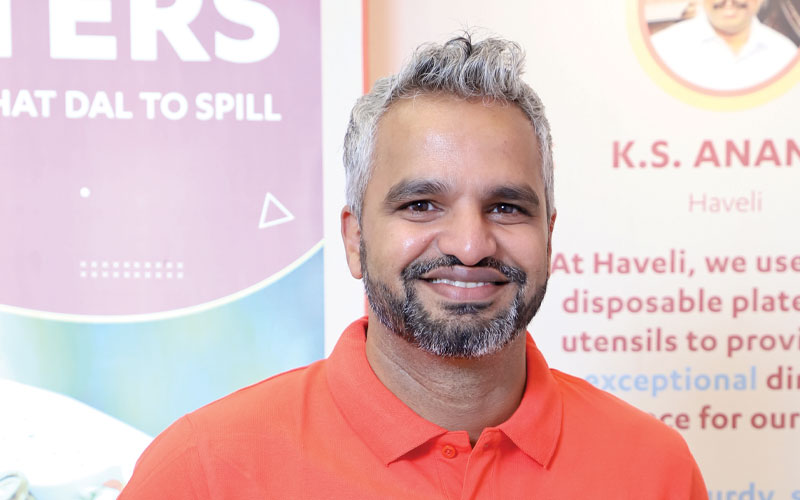It started with tableware like bowls and plates. Today, the Pakka-owned Chuk is developing complete delivery solutions. It launched delivery containers about two years ago, which was mid success because of the technological limitations. Our primary market focus has always been on Quick Service Restaurants (QSRs) and institutional catering, which includes large industrial caterers and entertainment facilities, says Mr. Satish ChamyVelumani, Business Head, Compostables Division, Pakka.

Paper Mart: What factors encouraged you to enter the compostable tableware market? How are you positioned today?
Satish ChamyVelumani: The need to make a cleaner planet. Secondly, the pollution around us is a major concern. Thirdly, our ability to develop a scalable product is key. Compared to the non-compostable tableware currently in use, our production volume is very small today. This is primarily because the technology is still in its early stages, and the industry is quite nascent.
For example, the daily usage of plastic tableware in the country is about 2000 tons, whereas all Indian manufacturers combined don’t produce more than 30 tons a day. This means we hold only about half a percent of the market. This leaves us with a huge 99.5% to capture.
PM: Give us a brief on the product range you cater. How much has it diversified?
SCV: We started with tableware like bowls and plates. Now, we’re developing complete delivery solutions. We launched delivery containers about two years ago, which was mid success because of the technological limitations. We’ve addressed those concerns and are launching a complete line of delivery solutions, including multi-compartment meal trays, containers, cups, and more. This isn’t a diversion, but rather an evolution.
Watch: Top Paper Companies 2023
PM: Where in India do your products enjoy strong demand? What new markets are you eyeing?
SCV: Roughly 60% of our sales come from the North region. However, our primary market focus has always been on Quick Service Restaurants (QSRs) and institutional catering, which includes large industrial caterers and entertainment facilities. This focus will continue, and we see even greater opportunities with the upcoming launch of our complete delivery solutions. We’re hopeful we can significantly support the delivery market, which is very exciting. While delivery solutions will be available nationwide, the general business has significant potential for growth in the South. We’ve only scratched the surface when it comes to major cities like Bangalore, Hyderabad, and Chennai, and we expect substantial movement there this year.
We have a production capacity of 300 metric tons per month at our own facility in Ayodhya. To meet growing demand, we’ve outsourced manufacturing to 5 companies. This is expected to increase our overall capacity to 600 metric tons per month
PM: What is your production capacity? Assuming increased market demand, how much will it change?
SCV: We have a production capacity of 300 metric tons per month at our own facility in Ayodhya. To meet growing demand, we’ve outsourced manufacturing to 5 companies. This is expected to increase our overall capacity to 600 metric tons per month.
PM: Please discuss the retail/distribution strategy you have adopted.
SCV: Our business is split in two categories – B2B & B2C. In B2B, we generate around 90-95% of our revenue. But it’s not always about the numbers. If you’ve looked at the biggest environmental impact from non-compostable tableware comes from institutional catering, which is why we started working with QSRs, entertainment facilities, temples, and many more. It’s a very simple thing – the best product is one that is available. So, we needed to make sure that our product is available in every nook and corner of the country, at least in the major cities. So, we deployed around 18 partners in the country in every metros and tier 1 cities. So, B2B is completely through partners.
B2C focuses on consumer awareness and has grown significantly from 5% to over 10-12% of our daily revenue in the past year. Our B2C strategy utilizes quick commerce platforms like Zepto, Instamart, and Blinkit, and we are also available on major e-commerce platforms like Amazon, as well as modern retail stores like DMart and Metro Mall. To sum up I can say that B2C primarily leverages quick commerce and e-commerce, with a presence in some modern retail stores.
PM: In terms of acceptance, how would you describe adoption of compostable tableware in India?
SCV: There is growing awareness of the environmental impact of non-compostable tableware. However, the cost remains higher than non-compostable alternatives due to the nascent stage of the industry, which limits economies of scale. We’re actively building awareness, and both consumer interest and production volume are increasing. Nevertheless, we have a long way to go.
Also Read: Grabeco: Revolutionizing Disposable Tableware
PM: What innovation/s have you introduced that have worked as a game changer for you? Please discuss.
SCV: Customer-first design is our DNA. Innovation doesn’t require a completely new technology; it focuses on product design, specifically how customers use the products. This is why our design process begins with understanding customer usage. For example, when designing a beverage cup, we consider how the customer holds it, pressure points, thumb placement, and the sipping experience. This user-centric approach has resulted in top-notch product design across our entire line. The angles in our multi-compartment trays, for instance, are carefully considered for optimal functionality.
PM: Give us a view of the compostable tableware market, in terms of growth and future, in India.
SCV: Two key points I mentioned earlier – firstly, we currently hold only about 0.5% of the total tableware market. This leads to a huge 99.5% market share waiting to be captured. There’s immense potential for growth. Secondly, consumer awareness is rising significantly. Our B2C business, initially contributing just 5%, has grown to 12%, and this upward trend is expected to continue. B2C plays a vital role in raising awareness – as more people discover our products, demand increases. Combining these factors, the industry is poised for a major boom.




